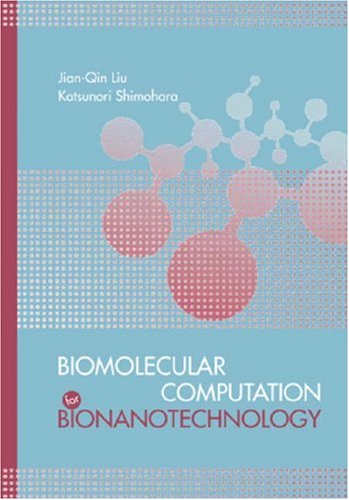Biomolecular Computation for Bionanotechnology
Jian-qin Liu
- 出版商: Artech House Publish
- 出版日期: 2007-04-04
- 售價: $5,310
- 貴賓價: 9.5 折 $5,045
- 語言: 英文
- 頁數: 286
- 裝訂: Hardcover
- ISBN: 1596930144
- ISBN-13: 9781596930148
-
相關分類:
奈米科技 Nano
無法訂購
相關主題
商品描述
Description:
This first-of-its-kind resource on molecular computation gives you a thorough grasp of the technologies, biochemical details, and theoretical models at the cutting edge of this multidisciplinary field, and provides you with a detailed roadmap to the challenges ahead. It explores advances in molecular biology and nanotechnology and illuminates how the convergence of various technologies, from nanobioscience to nanobioinformatics, is propelling computational capacity beyond the limitations of traditional hardware technology and into the realm of moleware.
At its core, this peerless volume gives you a definitive understanding of the nanotechnology tools, methods, and issues fueling the drive to non-silicon computing. It brings you up to speed on DNA computing and membrane computing, and describes nanobiomachines including NanobioICT and their potential in information processing and communications. You gain insight into techniques for representing and operating information by molecules, along with other key issues like controlling biomolecular signaling and designing algorithms for molecular computing and moleware communication. The book presents the biological and mathematical aspects of kinase computing as an example of molecular computation through cell-based nanobiomachines, and reviews the latest directions in molecular bioinformatics including protein interactome networks. With its wealth of models, algorithms, designs, and problem-solving applications, this volume is the first to bridge the gap between biomaterial sciences/molecular biology modeling and bioinformatics engineering for bionanoscale phenomena.
Introduction ?How to Go Beyond Traditional Computers? Scientific Motivation and Needs from Industries. Cutting-Edge Technologies for Building a Molecular Computer: From Nanobioscience and Nanotechnology to Nanobioinformatics. Challenges from Real-World Applications. Innovations and Breakthroughs in the New Millennium. Crucial Steps to Build a Molecular Nanobiocomputer. Preliminary in Nanobioscience.
The State-of-the-Art Molecular Biology and Nanotechnology ?Genomics. Proteomics and Protein Interactome Networks. Cellular Structure in the View of Molecular Biology. Cell as a Nanobiomachine. Signal Transduction and Signaling Pathways of Cells. Measurement, Detection, and Manipulation of Biological Molecules in Material Science. Pharmaceuticals Nanobioinformatics.
Nanobiomachines for Information Processing and Communications: Exploring Fundamental Principles of NanobioICT ?Missions of Nanobio ICT. Information Theory for NanobioICT: Shannon meets Feynman. Approaches to Nanobio ICT. A Glance at I nformatics of Moleware Communication. An Informatics Form of A Molecular Viterbi Algorithm Network Coding in Molecular Informatics. Quadruple Convergence.
Computing by Biomoleware: Diverse Methods from Diversified Materials ?How to Build an Engineered Computational Nanobiosystem: Inspiration from Existing Nanobiomachines in Nature. Information Processing in Artificial Nanobiosystems: An Odyssey Beyond the Blind Matchmaker. Computing by Nucleic Acids. Computing by Biochemical Reactions in Microbes.
Theoretical Biomolecular Computing ?Basic Concepts in Computer Science for Molecular Computing. Formalized Molecular computing. How to Design Algorithms for a Molecular Computer. Touchstone for Nanobio-oracle: Moleware Logic.
Cellular Biomolecular Computing Based on Signaling Pathways: Kinase Computing ?Cellular Pathway: Another Ubiquitous Society in Another Universe. The Molecular Switch As a Bridge Across Between Cell Communication and Molecular Computing. From Automaton to Rewriting: Towards General Parallel Computing. Blueprint of a Kinase Computer.
Comparison of Algorithms of Biomolecular Computing and Molecular Bioinformatics ?Formal Characteristics of Algorithms of Biomolecular Computing. Interactions in Molecular Bioinformatics Algorithms. Common-points of Biomolecular Computing and Molecular Bioinformatics on Algorithmic Aspect. Exploring Logical Description for Molecular Bioinformatics Based on Formalization and Abstract Operation.
Emerging Nanobiotechnology in Multi-Disciplines ?The Tale of Two Media: Molecular Electricity and Biomolecular Signaling. How Small Nanocomputer Can Be Made? A Nanocomputer That May Lead to Surpass the Turing Machine? Informatics of Porphyrin Systems. Transition from the Supporting Points to Integration of Different Aspects of Molecular Information Processing. Cell Communication for Engineering Purpose.
References.











